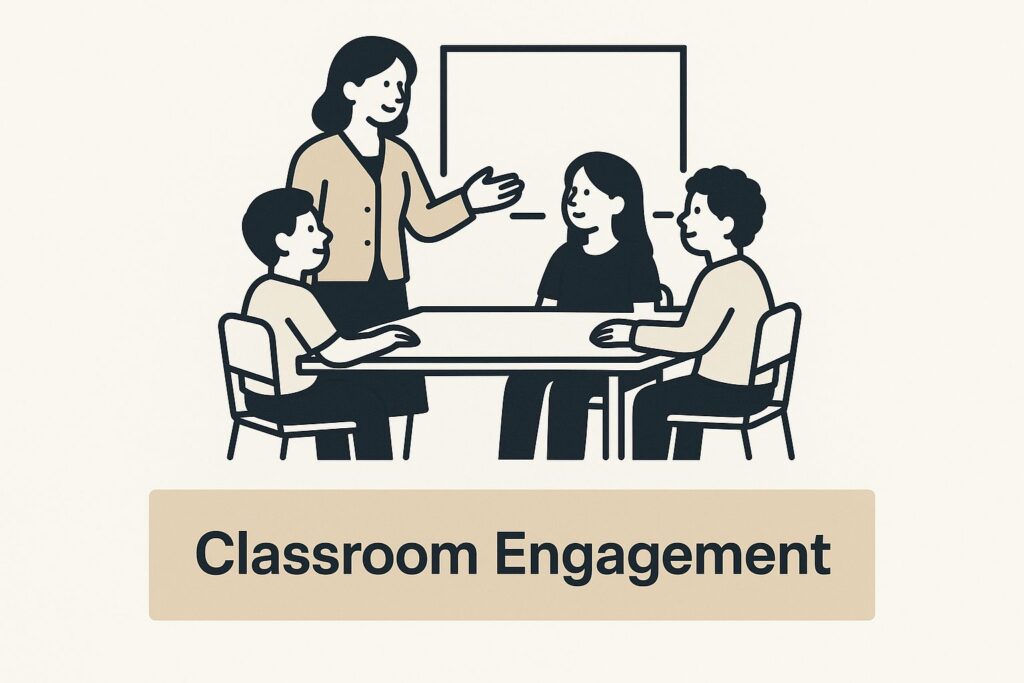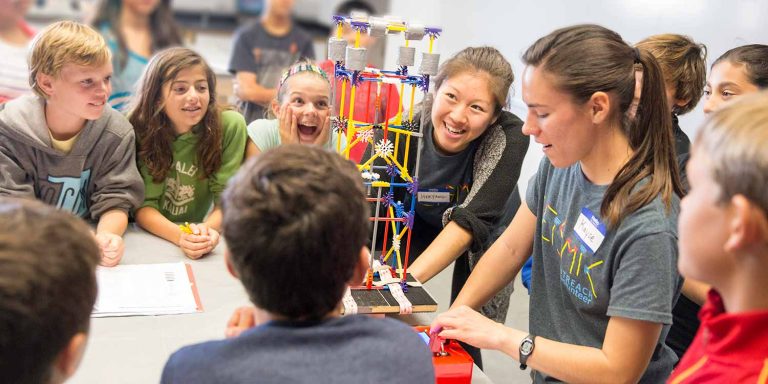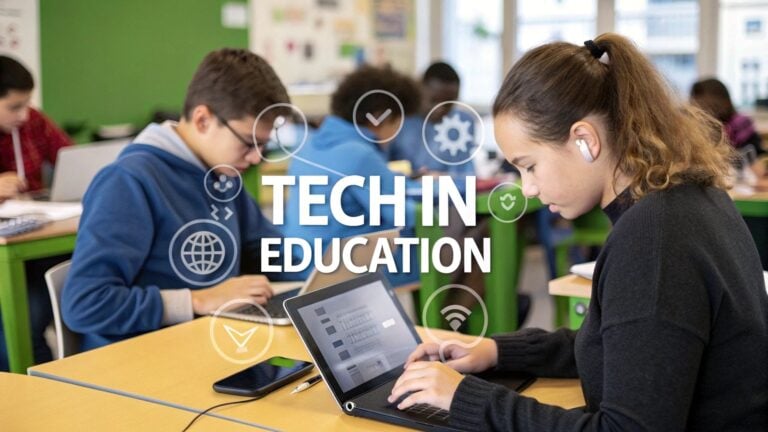Finding Your Effective Teaching Style

An effective teaching style isn’t a fixed personality trait you’re born with. I like to think of it as a flexible toolkit of strategies you can adapt to fit your students, the subject you’re teaching, and the unique energy of your classroom.
Unpacking What Makes a Teaching Style Effective
When I first started teaching, I obsessed over what my “style” should be. Was I the strict lecturer or the friendly facilitator? It turns out, that’s completely the wrong question to ask. An effective teaching style is about more than just picking a label and sticking with it.
It’s really about the dynamic set of actions and decisions you make every single day in the classroom.
The old debates, like teacher-led instruction versus student-led discovery, are starting to feel pretty dated. The modern reality is that the best educators are responsive and incredibly versatile.
Moving Beyond Fixed Labels
True effectiveness comes from blending research-backed strategies. You don’t have to squeeze yourself into a predefined box. A highly effective teacher can pivot their approach based on the specific needs of a lesson and, more importantly, the students right in front of them.
One day might call for crystal-clear direct instruction. The next might be perfect for a messy, collaborative, project-based activity.
This means your teaching style is something you can consciously build and refine over your entire career. It’s about what you do.
The core idea is simple but powerful:
An effective teaching style is measured by its impact on student learning. It’s an adaptable practice focused on creating the best possible conditions for students to understand, engage, and grow.
The Hallmarks of an Effective Approach
So, what does this actually look like in a real classroom? An educator with a genuinely effective teaching style usually has a few key characteristics.
- Adaptability: They effortlessly pivot their methods to suit different students, subjects, and learning environments, whether they’re teaching online or face-to-face.
- Student-Centered Focus: They make it their mission to understand student needs. They design activities that spark active participation and critical thinking, not just passive listening.
- Clear Communication: They have a knack for explaining complex topics in a way that just clicks. They also provide constructive feedback that actually helps students get better.
- Responsiveness: They are masters of reading the room. They watch, listen, and adjust their plans on the fly to make sure everyone is on the right track.
Building your own effective teaching style is about curating a rich toolkit of strategies you can draw from at any moment. You want to have the right tool for the right job, every single time.
The Five Pillars of High-Quality Teaching
So, if an effective teaching style is really an adaptable toolkit, what are the tools inside? It helps to think less about a single “style” and more about the fundamental goals of great teaching. We can break down high-quality instruction into five core pillars that work together to create an incredible learning environment.
A really insightful analysis from the OECD looked at 150 schools across 40 countries to figure out what the best teachers actually do day-to-day. They found that effective teaching is a flexible set of observable actions. You can learn more about their findings on high-quality teaching to see how these practices work across the globe.
Let’s dive into what these five pillars actually look like in a real classroom.
Sparking Cognitive Engagement
This is all about getting students to think deeply, not just spit back facts. An effective teaching style pushes learners to connect new ideas to what they already know, grapple with tough questions, and really work their brains. This approach creates true understanding instead of just memorization.
For instance, instead of just listing the causes of a historical event, you might challenge students to debate which cause was most significant and defend their reasoning with evidence. This is where the real, lasting learning happens, in the mental heavy lifting.
Delivering High-Quality Subject Content
You can’t get around it, you have to know your stuff. This pillar is about more than just expertise, though. It’s about presenting your subject matter with absolute clarity, making sure explanations flow logically, and using examples that actually click with your students.
This means breaking down big, complicated topics into smaller, more manageable chunks. It’s the art of making the complex feel simple without ever dumbing it down.
This infographic shows how these elements come together to create a powerful learning dynamic.

As you can see, when a teacher can connect with students on both a personal and an academic level, the whole classroom environment becomes far more effective.
Fostering Powerful Classroom Interaction
Learning is almost always a social activity. This pillar is all about creating a classroom where students learn from each other through rich discussion, collaboration, and shared problem-solving. You want to design tasks that genuinely require teamwork to succeed.
Here are a few ways to make it happen:
- Think-Pair-Share: Give students a quiet moment to think individually before hashing out their ideas with a partner and then sharing with the whole class.
- Jigsaw Activities: Assign each small group a different piece of a topic to become “experts” on. Then, they regroup to teach their peers.
- Group Projects: Structure projects where each student has a distinct role, making everyone accountable for their piece of the final outcome.
These strategies instantly turn passive listeners into active participants.
The goal is to build a classroom culture where every voice is valued and students see their peers as resources for learning.
Providing Social-Emotional Support
Students learn best when they feel safe, respected, and connected to their teacher and their classmates. This pillar is about intentionally building that supportive foundation. An effective teacher shows genuine care and invests in building positive relationships.
This looks like greeting students by name at the door, taking a moment to listen to their concerns, and creating a classroom where it’s okay to make mistakes. When students feel emotionally secure, they’re far more willing to take academic risks.
Using Formative Assessment
Finally, an effective teaching style is responsive. This means constantly checking for understanding and using that information to adjust your teaching on the fly. This isn’t about grades. It’s about gathering real-time data to guide your next move.
This could be as simple as using exit tickets at the end of class, carefully observing group work, or asking targeted questions to see who’s getting it and who might need a bit more support. This constant feedback loop ensures you’re meeting students exactly where they are.
Here’s a quick summary to pull it all together.
The Five Dimensions of Effective Teaching at a Glance
This table breaks down the five core pillars of high-quality teaching and what each one means for your daily classroom practice.
| Pillar | Core Focus | Example Classroom Action |
|---|---|---|
| Cognitive Engagement | Promoting deep thinking, critical analysis, and problem-solving. | Asking “why” and “how” questions instead of just “what.” |
| High-Quality Content | Presenting subject matter with clarity, logic, and relevant examples. | Breaking a complex scientific process into a step-by-step visual diagram. |
| Classroom Interaction | Encouraging student-to-student collaboration and discussion. | Using structured group projects where each student has a specific role. |
| Social-Emotional Support | Building a safe, respectful, and caring classroom environment. | Greeting each student by name at the door to start the day on a positive note. |
| Formative Assessment | Gathering real-time feedback to adjust instruction and meet student needs. | Using a quick poll or “exit ticket” to check for understanding before moving on. |
By weaving these five pillars into your teaching, you move beyond a single “style” and start building a truly dynamic and responsive learning environment.
Putting Theory Into Practice with Inquiry-Led Learning

Okay, so how do we actually bring those five pillars to life in a real classroom? One of the most powerful ways I’ve seen this happen is through inquiry-led learning.
This approach flips the traditional model on its head. Instead of me standing at the front of the room delivering information for students to absorb, I empower them to ask their own questions and steer their own investigations.
This isn’t about letting students run wild, though. It’s a carefully structured process of exploration, testing ideas, and thinking critically.
My role shifts from being the “sage on the stage” to the “guide on the side,” providing resources and gentle nudges to keep the learning on track. This is an incredibly effective teaching style because it naturally hits on all five pillars we just talked about.
How Inquiry-Led Learning Fosters Key Skills
When students are in charge of the questions, their cognitive engagement goes through the roof. They are genuinely curious and motivated to find solutions to problems they helped define in the first place. They are not just memorizing facts for a test.
This method is also a fantastic way to build essential life skills like problem-solving and collaboration. Students have to work together, share their findings, and navigate the occasional disagreement. In short, they learn to think for themselves, which is a much more valuable skill than simply repeating what they’ve been told.
Many forward-thinking teaching styles embrace this model. It’s become a cornerstone in many international education programs, like those in International Baccalaureate (IB) schools.
For instance, some schools embed inquiry-driven strategies across all their programs, making student curiosity the engine of instruction.
This approach champions active exploration and critical thinking over just sitting back and listening. You can explore how schools are using these strategies to see it in action.
The real beauty of inquiry-led learning is that it makes learning meaningful. When students see a direct connection between their questions and their discoveries, the entire experience becomes more relevant and memorable.
A Practical Example in Action
Imagine a science class studying ecosystems. The old-school approach might be a lecture on food webs followed by a worksheet. Yawn.
With an inquiry-led approach, I might start with a simple, open-ended question like, “What would happen if all the bees in our local area disappeared?”
From there, students would generate their own questions:
- What kinds of plants do bees pollinate here?
- How would their disappearance affect other animals?
- Are there other insects that could take their place?
This one question sparks a natural investigation where students research, gather data, and maybe even design a small experiment. They’re deeply engaged, collaborating, and using their social-emotional skills to work as a team. This specific style becomes the perfect vehicle for putting those broader principles of effective teaching into practice every single day.
Adapting Your Style for Different Learning Environments
A solid teaching philosophy is your foundation, but a truly effective teaching style has to work in the real world. That means knowing how to adapt your approach whether you’re in a traditional classroom, fully online, or juggling a hybrid model.

The core principles of good teaching, like clarity, engagement, and support, don’t change. But how you bring them to life absolutely does.
The biggest challenge is making sure every student feels seen and supported, no matter where they’re logging in from. Let’s break down how to make your style shine in each of these settings.
Thriving in the Traditional Classroom
In a face-to-face setting, you have the incredible advantage of physical presence. You can literally walk around the room, read body language, and use the space to shape the learning experience.
This is where you can lean into managing classroom dynamics and creating a lively, interactive environment. An effective teaching style here involves:
- Using Physical Space: Don’t let the room’s layout be an accident. Arrange desks for collaboration one day and for quiet, focused work the next. Use different corners of the room for different activities to keep the energy fresh.
- Reading the Room: This is your superpower in person. A quick glance tells you if a concept is confusing, if a joke landed, or if it’s time for a much-needed break. You can instantly gauge the energy and understanding of the group and adjust on the fly.
Engaging Students in the Online World
Teaching through a screen presents a completely different set of challenges. When students are surrounded by distractions at home, building a sense of community and keeping them engaged becomes your top priority.
You have to be much more intentional about creating connection and interaction. I’ve found that success in online teaching often comes down to a mix of clear structure and varied activities.
Using breakout rooms for small-group discussions can beautifully replicate the feel of in-person collaboration. Interactive polls and shared digital whiteboards are also fantastic for keeping students actively participating instead of passively watching.
The key online is to create predictable routines while also surprising students with engaging activities. It helps them feel connected to you and their peers, which is crucial for building a positive learning environment from a distance.
Bridging the Gap in Hybrid Models
Hybrid teaching is probably the trickiest of all. You have to simultaneously engage the students physically in the room and those joining remotely. The goal is to create one cohesive classroom culture, not two separate experiences happening at the same time.
This requires a really thoughtful approach to technology and activity design. To make it work, I focus on activities that put both groups on equal footing. For example, I have everyone, both in-person and remote, collaborate on the same digital document or participate in the same online poll.
This is a core concept in what’s known as blended teaching and learning explained in more detail in other guides. It’s all about finding that common ground to ensure no one feels left out.
Adapting Teaching Strategies Across Environments
While the environment changes, the principles of good teaching remain constant. The table below shows how you can adapt these core ideas whether your students are in the room, on the screen, or a mix of both.
| Principle | In-Person Application | Online/Hybrid Application |
|---|---|---|
| Building Community | Icebreakers, group projects, and collaborative seating arrangements. Casual conversations before and after class. | Dedicated “get to know you” forums, virtual breakout rooms for small talk, and regular check-in polls. |
| Active Engagement | Think-pair-share activities, whiteboard problem-solving, and physical movement breaks. | Interactive polls, digital Q&A tools, collaborative documents, and virtual whiteboards. |
| Clear Communication | Using voice tone, body language, and clear verbal instructions. Writing key points on a physical board. | Over-communicating instructions via email and LMS. Using clear, concise slides and a consistent weekly structure. |
| Providing Feedback | Walking around the room to give immediate, personal feedback. Collecting and returning physical assignments. | Using annotation tools on digital documents, providing audio/video feedback, and using rubric features in an LMS. |
| Flexibility | Adjusting the lesson plan based on the room’s energy and student questions. | Offering multiple ways to participate (chat, voice, forum) and providing recordings of live sessions for asynchronous review. |
Ultimately, adapting your style is about being intentional. You have to ask, “What does this group of students need from me in this specific environment to succeed?” Answering that question is the first step toward becoming a more versatile and effective educator.
Navigating the Real-World Hurdles to Great Teaching
Being a great teacher is about more than what happens inside the four walls of your classroom. An effective teaching style has to be tough enough to handle the real-world pressures we all face. It’s crucial to be realistic about the external factors that can make our jobs a whole lot harder.
From shoestring budgets and outdated materials to the ever-growing need for student mental health support, these challenges are very real. They hit us right where it counts and directly impact our ability to teach the way we know we should. The most effective teachers I know are pragmatic. They know how to adapt their style to the bigger picture.
Acknowledging the Squeeze
Let’s be honest, it’s tough to focus on inquiry-based learning when you don’t have enough textbooks to go around. It’s also nearly impossible to provide deep, social-emotional support when your own resources are stretched thin. These aren’t minor hiccups. They are significant, daily hurdles.
An effective teaching style today means being resourceful and creative. It means figuring out how to make a big impact with limited tools and learning to prioritize what matters most when you simply can’t do it all.
The Growing Role of Technology
New technology, especially AI, is another massive factor we have to contend with. It’s a powerful force that’s fundamentally changing how students learn and how we teach. It’s not just a shiny new toy.
Global trends show that an effective teaching style must now weave thoughtful tech integration into great pedagogy. This means creating ethical frameworks for using new tools like AI and getting the right training to use them well. You can see how these global trends are shaping education in detail on the OECD’s website.
This forces us to ask some big questions:
- How can we use these tools to support our teaching goals, not just for the sake of it?
- What training do we actually need to feel confident and competent?
- How do we ensure technology promotes equity instead of widening the gap?
Finding the right balance is a key part of this. Check out our guide on choosing between instructor-led and self-paced learning for a deeper dive into this topic.
Supporting the Whole Student
Beyond technology and budgets, there’s a growing awareness of just how critical student well-being is. A student wrestling with anxiety or stress can’t fully engage in a lesson, no matter how brilliantly it’s designed.
An effective teaching style today must be trauma-informed and centered on compassion. It involves creating a classroom that serves as a safe harbor, where students feel seen, heard, and supported emotionally as well as academically.
This is, arguably, the biggest challenge of all. It asks us to be more than just instructors, and to be consistently caring humans. It means acknowledging the tough stuff head-on and finding sustainable, practical ways to not just survive, but to help our students truly thrive. It’s the most important work we do.
How to Develop and Refine Your Teaching Style
Finding your groove as an educator is a process of small, intentional tweaks, not a complete overhaul. The best teaching styles are living, breathing things that adapt over time. It all starts with a little self-reflection.
The first step is simply becoming a keen observer of your own classroom. After a lesson, take five minutes to jot down what clicked and what felt clunky. Did students light up during the group activity, or did their energy nosedive the second you started the lecture? These quick notes are your starting point.
Gather Meaningful Feedback
Here’s the thing, you can’t see the whole picture from your own perspective. Gathering feedback from students and peers is an absolute goldmine for growth, and you don’t need a complicated survey to get started.
Try these simple methods:
- Student Exit Tickets: As students leave, ask them to answer a simple question like, “What was the most confusing part of today’s lesson?” or “What helped you learn the most today?”
- Peer Observation: Invite a trusted colleague to sit in on a class. Give them something specific to watch for, like how you manage transitions between activities or how many different students you call on.
This kind of feedback gives you concrete data to work with. You can move from a gut feeling about what might be working to an informed plan for what to try next.
Experiment in a Low-Stakes Way
Now for the fun part: experimenting. The key here is to make small, manageable changes so you don’t feel overwhelmed. Think of it like A/B testing your lessons.
For instance, you could try a new discussion format with one class while sticking to your usual method with another. See which one sparks a more dynamic conversation.
This low-stakes approach makes it so much easier to try new things without the pressure of reinventing the wheel. It lets you feel out what an effective teaching style is like in practice, one small change at a time.
The process of refinement is cyclical: observe, get feedback, experiment, and repeat. Over time, these small adjustments add up to a huge impact on your teaching and your students’ learning.
This is also a great time to think about the bigger picture. When you’re ready to design or refresh your materials to support your evolving style, our guide on how to create a curriculum has some great advice to get you started.
A Few Common Questions About Teaching Styles
Let’s tackle some of the most common questions I hear from fellow educators about finding the right approach. These quick answers should help reinforce the big ideas we’ve covered.
Is One Teaching Style Really Better Than The Others?
Honestly, no single teaching style is the “best” one. The most effective teachers I know are more like chefs with a full spice rack than cooks who only use salt.
They borrow from multiple styles and adapt their approach based on the subject, the students’ energy, and the goal of that specific lesson. The real aim is to build a flexible toolkit, not to force yourself into a rigid box. An effective teaching style is responsive and versatile, not dogmatic.
How Can I Adapt My Style For Students With Different Needs?
This really starts with getting to know your students as individuals. Quick, informal checks for understanding are your best friend here. They give you a real-time map of where everyone is at.
From there, the key is offering choices. For example, you could let students show what they know by writing an essay, creating a presentation, or building a model. This simple shift lets you cater to different learning preferences and needs without creating entirely separate lesson plans for everyone.
Developing your teaching style is an ongoing journey, not a final destination. It evolves throughout your career as you gain experience, learn new strategies, and connect with new groups of students.
Focus on making small, consistent improvements. Forget about searching for one perfect, final style you’ll stick with forever. The best style is the one that grows with you.






